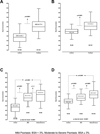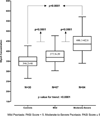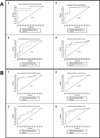GlycA Is a Novel Biomarker of Inflammation and Subclinical Cardiovascular Disease in Psoriasis
- PMID: 27654120
- PMCID: PMC5215065
- DOI: 10.1161/CIRCRESAHA.116.309637
GlycA Is a Novel Biomarker of Inflammation and Subclinical Cardiovascular Disease in Psoriasis
Abstract
Rationale: GlycA, an emerging inflammatory biomarker, predicted cardiovascular events in population-based studies. Psoriasis, an inflammatory disease associated with increased cardiovascular risk, provides a model to study inflammatory biomarkers in cardiovascular disease (CVD). Whether GlycA associates with psoriasis and how it predicts subclinical CVD beyond high-sensitivity C-reactive protein in psoriasis is unknown.
Objective: To investigate the relationships between GlycA and psoriasis and between GlycA and subclinical CVD.
Methods and results: Patients with psoriasis and controls (n=412) participated in a 2-stage study. We measured GlycA by nuclear magnetic resonance spectroscopy. National Institutes of Health (NIH) participants underwent 18-F Fluorodeoxyglucose Positron Emission Tomography Computed Tomography (18-FDG PET/CT) scans to assess vascular inflammation (VI) and coronary computed tomographic angiography to quantify coronary artery disease burden. Psoriasis cohorts were young (mean age=47.9), with low cardiovascular risk and moderate skin disease. high-sensitivity C-reactive protein and GlycA were increased in psoriasis compared with controls (GlycA: [PENN: 408.8±75.4 versus 289.4±60.2, P<0.0001; NIH: 415.8±63.2 versus 346.2±46, P<0.0001]) and demonstrated a dose-response with psoriasis severity. In stage 2, VI (β=0.36, P<0.001) and coronary artery disease (β=0.29, P=0.004) associated with GlycA beyond CV risk factors in psoriasis. In receiver operating characteristic analysis, GlycA added value in predicting VI (P=0.01) and coronary artery disease (P<0.01). Finally, initiating anti-tumor necrosis factor therapy (n=16) reduced psoriasis severity (P<0.001), GlycA (463.7±92.5 versus 370.1±78.5, P<0.001) and VI (1.93±0.36 versus 1.76±0.19, P<0.001), whereas GlycA remained associated with VI (β=0.56, P<0.001) post treatment.
Conclusions: GlycA associated with psoriasis severity and subclinical CVD beyond traditional CV risk and high-sensitivity C-reactive protein. Moreover, psoriasis treatment reduced GlycA and VI. These findings support the potential use of GlycA in subclinical CVD risk assessment in psoriasis and potentially other inflammatory diseases.
Keywords: cardiovascular disease; coronary artery disease; inflammation; psoriasis; risk factors.
© 2016 American Heart Association, Inc.
Conflict of interest statement
AND FINANCIAL DISCLOSURES: All other authors declare no conflicts of interest to disclose.
Figures



Comment in
-
Glycosylation Signatures of Inflammation Identify Cardiovascular Risk: Some Glyc It Hot.Circ Res. 2016 Nov 11;119(11):1154-1156. doi: 10.1161/CIRCRESAHA.116.310005. Circ Res. 2016. PMID: 28051777 Free PMC article. No abstract available.
References
-
- Libby P. Mechanisms of acute coronary syndromes and their implications for therapy. The New England journal of medicine. 2013;368:2004–2013. - PubMed
-
- Ridker PM. High-sensitivity C-reactive protein, inflammation, and cardiovascular risk: from concept to clinical practice to clinical benefit. American heart journal. 2004;148:S19–S26. - PubMed
-
- Ritchie Scott C, Würtz P, Nath Artika P, Abraham G, Havulinna Aki S, Fearnley Liam G, Sarin A-P, Kangas Antti J, Soininen P, Aalto K, Seppälä I, Raitoharju E, Salmi M, Maksimow M, Männistö S, Kähönen M, Juonala M, Ripatti S, Lehtimäki T, Jalkanen S, Perola M, Raitakari O, Salomaa V, Ala-Korpela M, Kettunen J, Inouye M. The Biomarker GlycA Is Associated with Chronic Inflammation and Predicts Long-Term Risk of Severe Infection. Cell Systems. 1:293–301. - PubMed
MeSH terms
Substances
Grants and funding
LinkOut - more resources
Full Text Sources
Other Literature Sources
Medical
Research Materials

